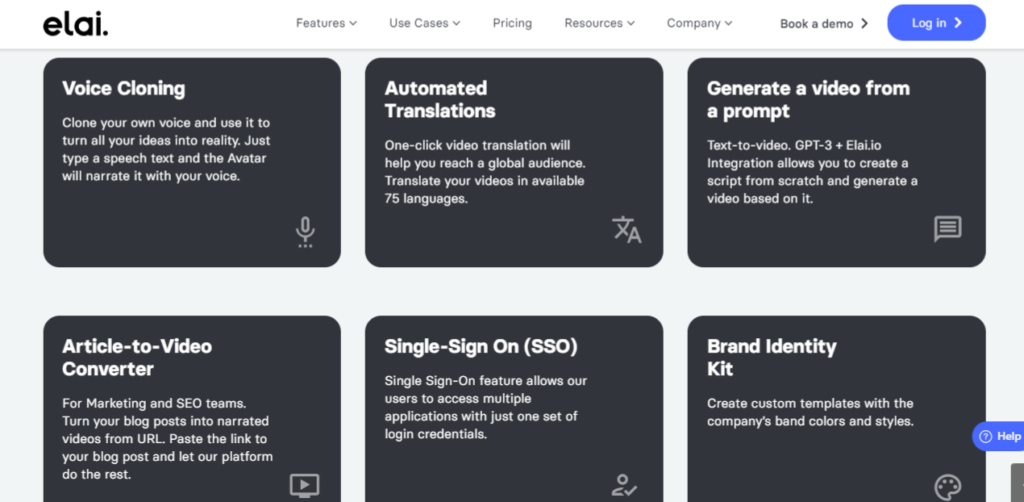Artificial intelligence (AI) continues to make significant strides in every sector, consistently offering ground-breaking solutions that are challenging the conventional boundaries of technology. Among the myriad AI applications, voice cloning has emerged as a game-changer with the potential to disrupt various domains. Especially notable is the technology’s capability to clone voices across multiple languages, including Spanish. This development brings about a multitude of opportunities for content creators, educators, marketers, and several other professionals, opening new avenues for exploration.

Voice Cloning Spanish: Transforming Digital Narration with Elai.io
At the forefront of this tech revolution is Elai.io, an AI-based platform recognized for its innovation in voice cloning. The platform not only enables Spanish voice cloning but extends this functionality to numerous other languages such as English, German, Polish, Italian, French, Portuguese, and Hindi. Elai.io is a testament to the transformative power of AI, leveraging this revolutionary technology to simplify content creation processes, enhance productivity, and nurture an environment of innovation in the realm of digital communication.
Unraveling the Importance of Spanish Voice Cloning
Language is an essential component of our identities and forms the crux of communication. For individuals and businesses striving to forge a deeper connection with their audiences, the ability to deliver content in the audience’s native language, like Spanish, is a monumental advantage. Spanish voice cloning provides creators with the tools to produce content that resonates more profoundly with their audience, creating a more engaging and memorable user experience.
Moreover, voice cloning to Spanish proves to be an invaluable asset for businesses venturing into Spanish-speaking markets. It enables companies to approach marketing and customer service with a personalized, culturally sensitive lens, considerably amplifying their engagement and overall impact.
Delving Deeper: How Does Elai.io Facilitate Voice Cloning?
The process of voice cloning with Elai.io is designed to be straightforward and user-friendly, ensuring accessibility to a broad range of users. To clone a voice, users must supply a well-prepared voice recording that is between 1 to 5 minutes long and devoid of any background noise. The AI system then processes this recording to create a digital rendition of the user’s voice, capturing the unique speech patterns, intonations, and emotional nuances.
For Spanish voice cloning, users can record their speech in any language. The resulting cloned voice can narrate videos in Spanish with precise pronunciation and accurate inflections. This capability allows users to extend their reach to Spanish-speaking audiences, regardless of their linguistic abilities.

Upping the Ante with Personalization
Elai.io goes above and beyond voice cloning by offering users the possibility of creating a digital twin. This feature, combined with a cloned voice, infuses videos with a personal touch, significantly augmenting your brand’s communication strategies with your audience.
Designed to mimic human voices closely, Elai.io’s digital voices create a sense of familiarity and relatability for listeners. In striving to establish a deeper connection between users and their audiences, Elai.io is contributing substantially to the effort to make AI-powered communication more human-centric.
Beyond Voice Cloning: Expanding the Horizon with Elai.io
Elai.io’s offerings extend far beyond voice cloning. The platform also provides users with the option to create unique avatars for their videos. Users can select from a wide range of avatar types, such as selfie avatars generated using a smartphone or webcam, or animated mascots tailored to their preferences. This comprehensive, interactive platform empowers users to create a diverse spectrum of content, all while preserving their unique personal touch.

AI Voices and Their Impact on Industries
As we delve deeper into the topic, it’s important to note how voice cloning, particularly voice cloning Spanish, has potential implications across various sectors. In education, for example, Spanish voice cloning could help in creating e-learning content that appeals to a wide demographic of students who are native Spanish speakers or are learning Spanish as a second language.
In the entertainment industry, Spanish voice cloning can be used for dubbing films or series in Spanish, thus widening their audience base. Also, in the field of journalism and media, Spanish voice cloning could help produce news segments and reports in Spanish with the same intonation and emotion as the original reporter.
Furthermore, Spanish voice cloning has significant potential for applications in the tech industry. For instance, it can be used to develop voice assistants that communicate effectively in Spanish or for creating interactive voice response (IVR) systems for businesses operating in Spanish-speaking regions.
A Boon for Accessibility: Spanish Voice Cloning and Its Implications
Another critical aspect to consider in the broader narrative of Spanish voice cloning is the substantial implications for accessibility. Individuals with speech and hearing impairments stand to benefit immensely from advancements in this domain.
The integration of Spanish voice cloning into assistive technologies can provide these individuals with a new medium of communication. For example, text-to-speech applications that use cloned voices can help people with speech impairments communicate their thoughts and ideas more effectively.

The Role of Spanish Voice Cloning in Voice-First Technologies
The rise of voice-first technologies such as Amazon’s Alexa, Google Assistant, and Apple’s Siri showcases the shift in user interaction from visual to auditory. Spanish voice cloning can enhance these voice-activated AI assistants’ ability to understand and respond to users in fluent Spanish.
The integration of high-quality Spanish voice cloning into these systems can offer more personalized interactions, making these technologies more useful and appealing to Spanish-speaking users. This can open up new markets for these devices in Spanish-speaking countries and amongst Spanish-speaking populations around the world.
Spanish Voice Cloning in Language Learning
As we progress in the digital age, traditional methods of language learning are being supplemented and often replaced by online platforms and applications. Here, Spanish voice cloning can play an instrumental role.
Imagine an application that uses a cloned voice to teach Spanish. The voice cloning technology can mimic the exact pronunciations, tone, accent, and speed of a native Spanish speaker, providing an authentic language learning experience. This can help learners perfect their accent and pronunciation, leading to more fluent Spanish-speaking skills.

Concluding Thoughts
Spanish voice cloning, made possible by pioneering platforms like Elai.io, is a shining testament to the transformative potential of AI. It opens up unparalleled opportunities for content creators, marketers, and businesses, enabling them to establish personal and effective communication with their Spanish-speaking audiences.
As we venture further into the digital age, voice cloning, particularly in languages like Spanish, will continue to shape the landscape of digital communication. It promises to lessen our reliance on traditional voice acting and revolutionize the way we generate and consume content. Thus, embracing this cutting-edge technology today allows you to be a forerunner in the world of AI-powered narration.
